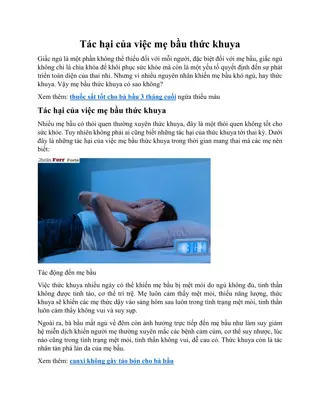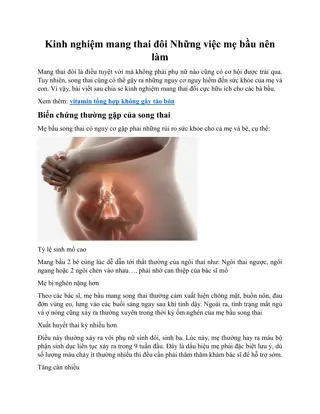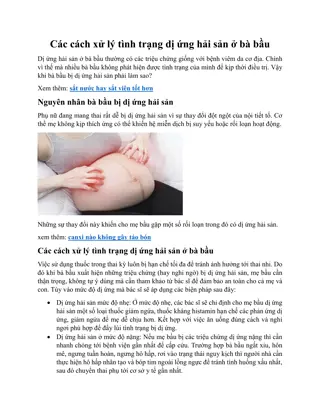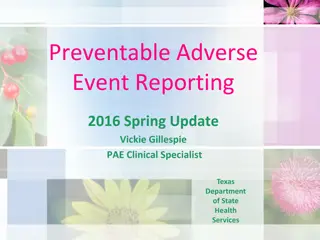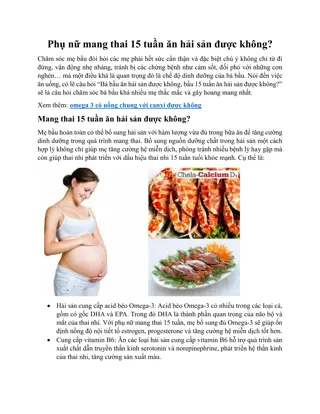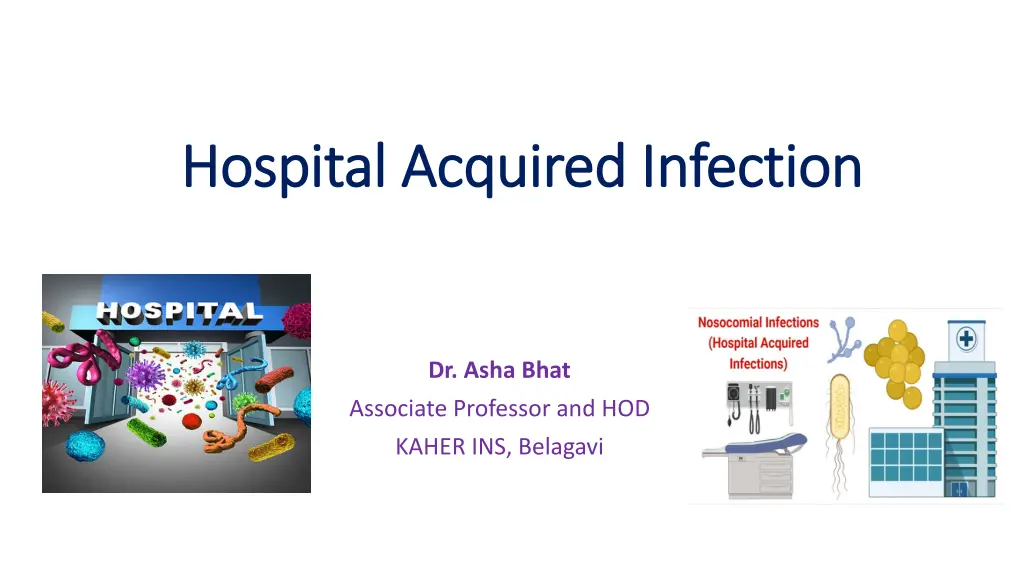
Hospital Acquired Infection Overview
Learn about Hospital Acquired Infections (HAIs) and the importance of prevention through a bundle approach targeting specific types of infections like urinary tract infections, surgical site infections, ventilator-associated events, and central line-associated bloodstream infections. Explore the definition of infections, types, and characteristics of primary and secondary infections. Understand the challenges and implications of nosocomial infections in healthcare settings.
Download Presentation

Please find below an Image/Link to download the presentation.
The content on the website is provided AS IS for your information and personal use only. It may not be sold, licensed, or shared on other websites without obtaining consent from the author. If you encounter any issues during the download, it is possible that the publisher has removed the file from their server.
You are allowed to download the files provided on this website for personal or commercial use, subject to the condition that they are used lawfully. All files are the property of their respective owners.
The content on the website is provided AS IS for your information and personal use only. It may not be sold, licensed, or shared on other websites without obtaining consent from the author.
E N D
Presentation Transcript
Hospital Acquired Infection Hospital Acquired Infection Dr. Asha Bhat Associate Professor and HOD KAHER INS, Belagavi
Overview HAI (Hospital acquired Infection) Hospital acquired infection Bundle approach - Prevention of Urinary TractInfection (UTI) - Prevention of Surgical SiteInfection (SSI) - Prevention of VentilatorAssociated events (VAE) - Prevention of Central LineAssociated Blood Stream Infection (CLABSI) Surveillance of HAI Infection control team & Infection control committee
Introduction Microorganisms are necessary for normal body functions. Some organisms produce food and maintain normal planet s ecology. The moment harmony is upset, microorganisms are capable of producing diseases. An infection occurs when a disease-causing organism enters the body and starts to multiply when they come in contact with favorable environment. An infectious disease is any disease caused by the growth of pathogenic microbes in the body. It may or may not be communicable
Definition Invasion of a host organism s bodily tissues by disease-causing organisms, their multiplication, and the reaction of host tissues to these organisms and the toxins they produce. Infections are caused by microorganisms such as viruses, prions, bacteria, and viroids and larger organisms like parasites and fungi. Infection is the establishment of the organisms in the tissues resulting in injury or harmful effect to the host.
Types Primary infection vs. secondary infection Primary Infection : An infection that develops in an otherwise healthy individual. Secondary Infection: An infection that develops in an individual who is already infected with a different Pathogen. Localized infection vs. systemic infection Local or Localized Infection : An infection that is restricted to a specific location or region within the body of the host. Systemic Infection: An infection that has spread to several regions or areas in the body of the host.
Introduction Hospital acquired infection is also called Nosocomial infection or Healthcare-associated infections. "nosus" = disease "komeion" = to take care of Nosocomial infections can be defined as infection acquired by the person in the hospital, manifestation of which may occur during hospitalization or after discharge from hospital. The person may be a patient, members of the hospital staff and/ or visitors.
EPIDEMIOLOGICAL INTERACTION EPIDEMIOLOGICAL INTERACTION HOST FACTORS: Suppressed immune system due to Age, Poor nutritional status, severity of underlying disease, complicated diagnostic & therapeutic procedure THE ENVIRNOMNET: Everything that surrounds the patient THE AGENT: in the hospital is his environment. Varieties of organisms Other patients Institutional and human Hospital staff and visitors Eatables Reservoirs & their virulence Dust and other contaminated articles
HAI Any one of the following mentioned condition is needed to call it as primary HAI: With in 48 hours of admission to hospital or any other supplementary health care facility Within 30 days of any surgical operation in the hospital premises Within three days of discharge from hospital Occurs one every 10 patients
RISK FACTORS Susceptible Hospital ambience patients Antibiotic resistant Invasive procedures pathogens Improved medical technology
Categories of Microbes - WHO P this categories of microbes includes conventional pathogens, which cause the disease in a healthy person in the absence of specific immunity and leading cause for institutional out breaks C in this category conditional pathogens that cause disease other than local infection, only with reduced resistance to infection, broken skin etc O this category of pathogens are opportunist pathogens that cause generalized disease among the patients with profoundly diminished resistance to infection
TYPES OF HOSPITAL ACUIRED INFECTION 1 2 3 4 5
Blood Stream Infection Serious infections Has high mortality Associated with intra vascular catheters Usually occur at entry site - tunnel infection Aseptic precautions taken and care given after insertion, duration etc matters for the infection Organisms are - E coli, enterococcus, Staphylococcus aureus, salmonella, candida, coryne bacterium
Urinary tract Infection Most common infection 30-35% among all HAI Associated with indwelling catheters Infection may be endogenous, or exogenous Causative organism: E coli, enterococcus, Klebsiella, salmonella, candida, proteus etc. Diagnosis fever, suprapubic tenderness, dysuria, pyelonephritis and septicaemia
Urinary tract Infection contd. Risk factors: ID catheter, instrumentation of UT, poor aseptic precaution, advanced age, females and sever underlying disease Prevention: Avoid unnecessary catheterization Use aseptic precaution during catheterization Follow the recommended guidelines during catheter care Review daily and change if it is necessary
Ventilator Assocaited Infection It is more serious health associated infection High case fatility with serious comorbidities Risk factors: age, coronary bypass surgery, abdominal surgery, medications Diagnosis: fever, cough, purulent sputum, gram staining, endotracheal aspiration
Ventilator Associated Infection contd. Prevention Elevation of head end Daily sedative interruption and daily assessment of readiness to extubate Peptic ulcer disease prophylaxis DVT Prophylaxis Daily oral care
Surgical Site Infection Earlier known as wound infection Incidence 0.5 to 15 % Usually occurs with in 30 days of surgery Risk factors : extent of contamination, duration of surgery, patients general condition Types: Superficial and Deep
Surgical Site Infection contd. Prophylactic antibiotics Appropriate hair removal Control of blood glucose Postoperative normothermia
Gastro Intestinal Infection Common in pediatric ward and in community Spread through contaminated environment, toilets, inadequate hand washing Risk factors : Age, antibiotics, decrease in normal flora, antibiotic resistance, over growth of micro organism, understaffing and inadequate hand washing
DIAGNOSIS CBC- to look for an increase in white blood cells Urine analysis- to look for white cells or evidence of blood in the urinary tract. Cultures- of the infected area, blood, sputum, urine or other body fluids to find causative organisms. Evaluation of symptoms and signs of infection Examination of wounds and catheter entry sites for redness, swelling or pus or abscess Chest X-ray Complete physical examination.
TREATMENT BACTERIAL INFECTIONS: the isolated organism is tested for sensitivity. Treatment begin with broad spectrum antibiotics such as penicillin, cephalosporin, tetracyclines or erythromycin. FUNGAL INFECTIONS: antifungal agents like amphotericin B, ketoconazole, itraconazole and fluconazole are used. VIRAL infection: anti viral drugs that slow the growth or reproduction of viruses, such as acyclovir, ganciclovir foscarnet are used.
PREVENTION OF HAIs Regular hand washing by health care workers and visitors Aseptic techniques i.e use of sterile gowns, gloves, mask and barriers Sterilization of all reusable equipment such as ventilators, humidifiers etc Disinfection of excreta and infected materials An infection control practitioner for every 200 beds should be employed.
CONTROL OF HAIs (INFECTION CONTROL POLICY) Every hospital must have an effective hospital acquired infection control committee (HAICC) CHAIRPERSON- medical superintendent Member secretary- infection control officer(microbiologist) Members- chief of all depts Invited members- chief of all supportive services(OT), CSSD, housekeeping, laundry etc
They should review; meeting once a month Infection control activities of hospital Hospital environment Sterilization and disinfection procedures Antimicrobial sensitivity pattern of prevalent pathogens Emergence of drug resistance among pathogens Use of different antimicrobial agents against which pathogens show no resistance
HOSPITAL ACQUIRED INFECTION CONTROL TEAM (HAICT) Infection control officer- microbiologist Infection control Nurse- hospital Nurse Clinician- clinician from hospital HAICT should meet once a week to look after: Surveillance- proper monitoring Control of infection Monitoring of hygienic practices.
HOSPITAL INFECTION CONTROL PROGRAMME It is dedicated to assisting the public health services, state and local health departments, hospital and other professional organizations in the prevention and control of nosocomial infections. The aim of the HICP is dissemination of information, surveillance activities, investigation, prevention and control of nosocomial infection in the hospital.
Infection control programme should include 1. Organised surveillance and control activities 2. One infection control practitioner for every major health facility 3. A trained hospital epidemiologist (someone who studies diseases and how they are found, spread, and controlled in groups of people) 4. A system for reporting surgical wound infection rates
Guidelines and recommendations Hand washing and hospital environment control Immunization Infectious diseases control Intravascular device related infections and their control Isolation precautions Long term care facilities Guidelines for infection control in health care personnel Surgical site infection control Sterilization/disinfection


